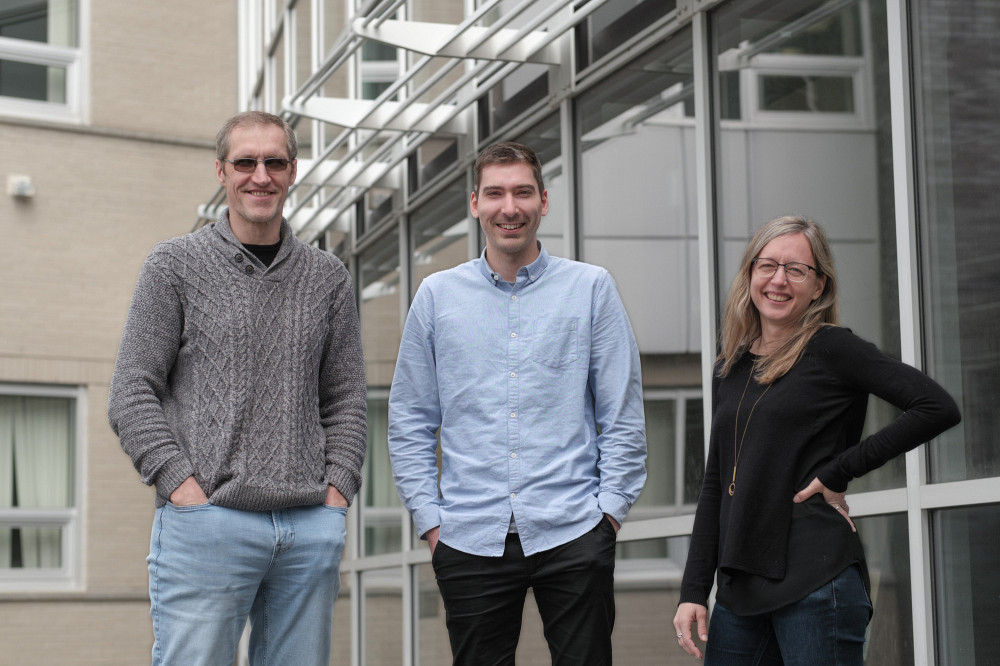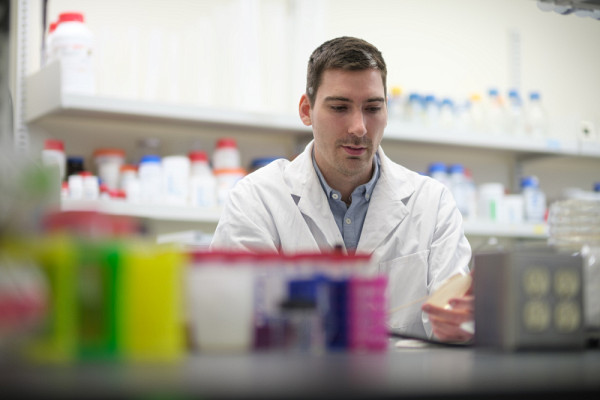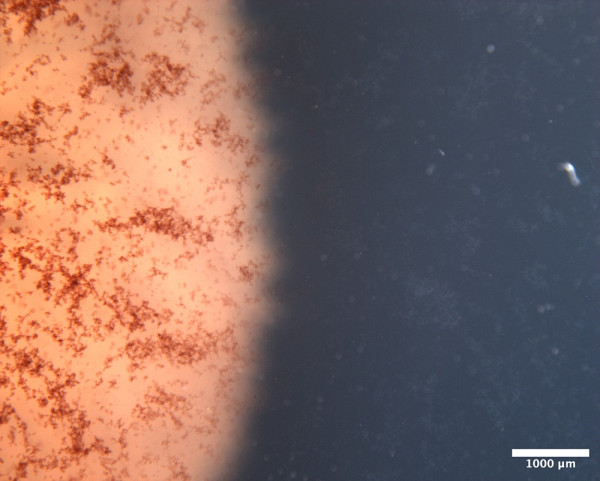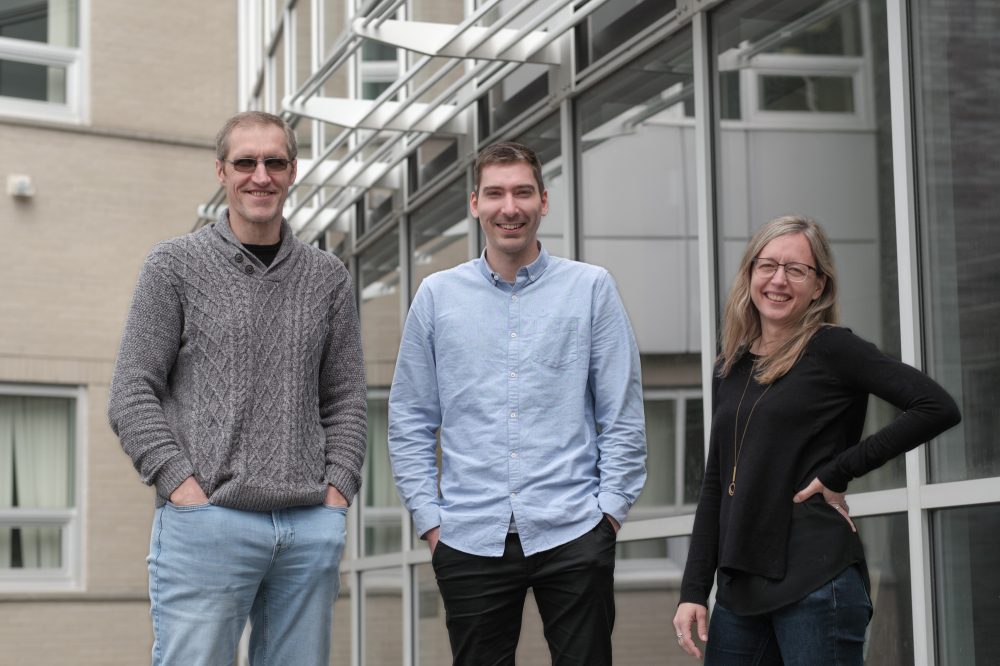
Photo: Michel Caron – UdeS
The progress of Vincent Charron-Lamoureux’s PhD project resembles a quest in a role-playing game: you have to solve puzzles, go through different stages and join forces with other players. By combining the expertise of other researchers in microbiology, biogeochemistry, electrochemistry and synthetic chemistry, he was able to discover the essential role of pulcherrimin in the Iron War.
And this is exactly where Vincent Charron-Lamoureux and the research team from the University of Sherbrooke begin their search.
From a simple color change to the discovery of a new iron management mechanism in bacteria
The story begins when Vincent and his superior, P.D Pascale B. Beauregard, noticed the appearance of a reddish color when their favorite bacteria were allowed to grow in the presence of competing bacteria. Clues in the literature and a few experiments later, they were able to confirm that the color was due to a connection between pulcherriminic acid, produced by their favorite bacteria, and iron present in the medium on which the bacteria grew.

Photo: Michel Caron – UdeS
The first mystery emerges: the binding of this molecule to iron leads to its precipitation, while most bacteria in the soil release the molecules to dissolve the iron. Furthermore, the literature claims that the iron trapped in this bond would be irreversible. Since bacteria depend on this element for their survival, why go to such trouble to produce a molecule that locks them in and precipitates them?
The team then set themselves the challenge of understanding why the bacterium defies traditional methods by producing pulcherriminic acid and depositing iron into pulcherrimin.
The importance of iron for living organisms
Iron is an essential element for the survival of living organisms, from bacteria to mammals. It has multiple roles in the functioning of organisms, such as DNA synthesis, oxygen transfer or electron transfer essential for energy production. However, in an oxidizing environment where it precipitates and forms granules with other elements, it is very poorly bioavailable to organisms, which have to compete with strategies to dissolve it and make it available again. The acquisition of iron is therefore the subject of fierce competition between living organisms that have developed different strategies aimed at recovering this essential micronutrient.
Iron-carrying molecules, “siderophores”
One strategy for iron acquisition by bacteria consists in the production of small organic molecules with a high affinity for iron to form complexes that are water-soluble and accessible to bacteria. Among these molecules, siderophores (from the ancient Greek siderophoros, “carrier of iron”) are the most effective and are produced by many microbes on the planet. Many microorganisms have also evolved intracellular iron storage structures, which allow them to manage requirements more efficiently independent of fluctuations in the availability of iron outside the cell. Although effective, these strategies come with significant energy costs.
Two proven roles of pulcherrimin
To complete his quest, Vincent Charron-Lamoureux chose his tools: Bacillus subtilisas a model bacterium that produces pulkeriminic acid, and bacteria Pseudomonas protects, as a competitive model.
We observed that the iron content of the Bacillus subtilis biofilm increased when it produced pulcherriminic acid, which was the first evidence that bacteria can take up iron from pulcherrimin.
Vincent Charron-Lamoureux, PhD student in biology

Photo: Provided
Thanks to his experiments, Vincent demonstrated the first role: in the presence of a competitor, the production of pulcherriminic acid creates a local extracellular reserve of iron, which can then be recovered by the siderophore bacillibactin B. subtilis.
This strategy is counterintuitive, as it aims to precipitate iron outside the cell, thus making it less available. However, this study shows that this strategy is viable as it is closely related to the common iron acquisition strategy using siderophores. To keep the Iron War analogy, this strategy is similar to destroying a bridge during a conflict to cut off the enemy’s supply lines.
To continue the various phases of their research on pulcherrimin, Vincent Charron-Lamoureux and Pascale B. Beauregard joined forces with three professors from the Department of Chemistry, namely Jean-Philippe Bellenger, an expert in biogeochemistry, Claude Legault, an expert in synthetic chemistry, and Philippe Dauphin -Ducharme, specialist in electrochemistry. This association highlighted the fact that pulcherrimin has another role, crucial for cell survival.
Another role of pulcherrimin that we have confirmed is that it reduces stress caused by reactive oxygen molecules. This oxidative stress, if not resolved, can cause DNA damage and lead to bacterial death. Therefore, the bacterium uses pulcherrimine to counteract the increase in oxidative stress caused by the competitor in its environment.
Vincent Charron-Lamoureux
Taken together, this study reveals that pulkerimic acid is at the center of a complex iron management strategy that promotes controlled extracellular deposition of iron when B. subtilis faces certain competitors. It is changing the understanding of iron management by bacteria not only in soil, but also in their interactions with humans and animals.
This new unsuspected “iron war” strategy was published in a scientific journal Nature Communications.

